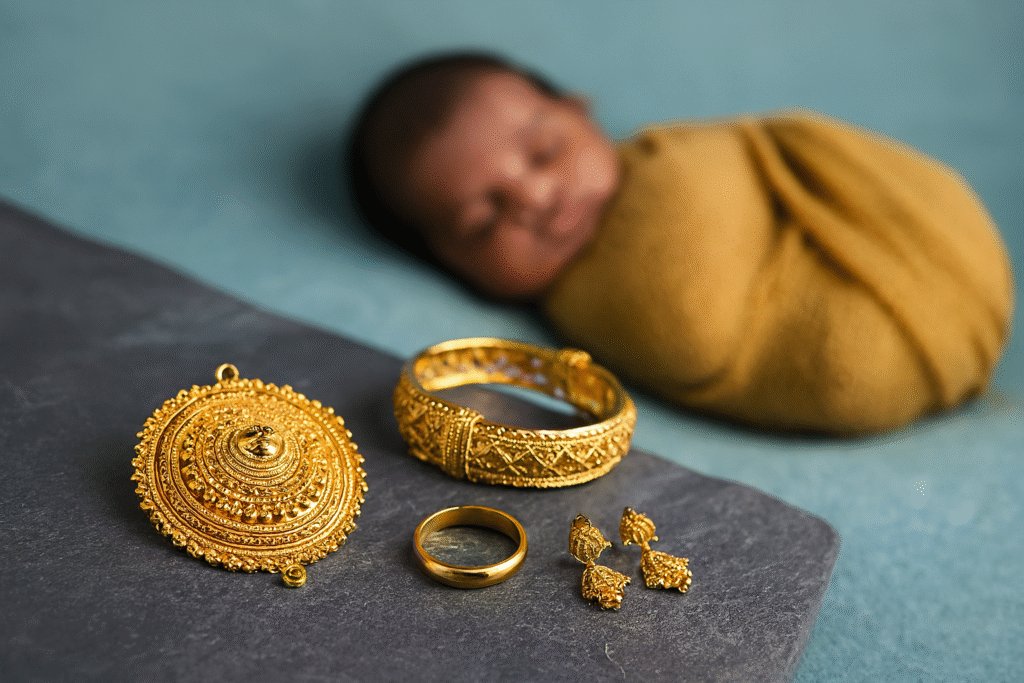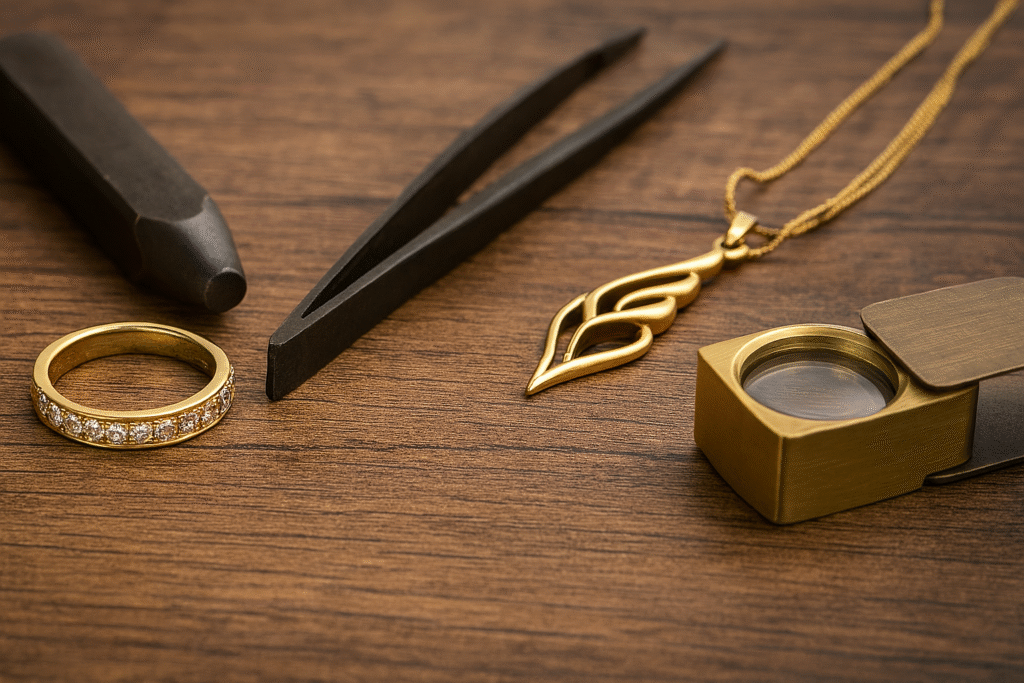Why Buying Gold for a Newborn in Kerala Matters
Buying gold for a newborn in Kerala is more than a gift. It is a tradition deeply tied to family, culture, and blessings. Parents usually choose bangles, chains, or an Aranjanam. But not every design is safe. Many families unknowingly make choices that can harm the baby. In this guide, I’ll explain the three biggest mistakes and show you how to choose jewellery that is safe, practical, and meaningful.
Mistake 1: Choosing Jewellery with Sharp Edges When Buying Gold for a Newborn in Kerala
A newborn’s skin is soft and sensitive. Even a small edge on a bangle can cause scratches or bleeding. In my 40+ years of experience, I’ve seen families return distressed because a “beautiful” design hurt their baby. The key is simple: always check ornaments for smooth finishes. If it scratches your finger, it is not safe for a newborn.
For more guidance, read my Gold Buying Checklist for Malayalis.
Mistake 2: Buying Tight Ornaments for Newborns in Kerala
An Aranjanam that fits snugly may look elegant, but it can reduce blood flow. Medical studies show that 20% of jewellery-related infant emergencies involve circulation issues (NCBI). Always choose adjustable designs and leave room for growth.
To understand why Aranjanam carries cultural importance, explore the post on the Cultural Meaning of Aranjanam in Kerala.
Mistake 3: Choking Hazards in Baby Jewellery in Kerala
Charms, beads, and dangling parts may seem attractive, but they can be deadly. Research shows 14% of choking incidents in infants under one year are linked to small accessories (World Gold Council). Always pick plain, sturdy ornaments.
For assurance about purity and safety, see Understanding BIS Hallmark in Jewellery.
Safe and Practical Gold Jewellery Options for Newborns in Kerala
- Rounded bangles with smooth edges
- Adjustable waist chains (safe Aranjanam)
- Lightweight, plain pendants
Not sure which gold type is best? The guide on 24K vs 22K vs 18K Gold Explained covers everything you need to know.
Expert Advice for Buying Gold for a Newborn in Kerala
In my decades of work in gems and jewellery, I’ve advised many families. The key is this: safety comes before weight or style when buying gold for a newborn in Kerala.
For more design inspiration, see Safe Jewellery Designs for Children.
FAQ
Q1: Can newborns wear earrings immediately?
No. Wait at least six months and consult a doctor.
Q2: How much gold should I buy for a newborn in Kerala?
Traditionally, families buy 2–4 grams. Focus on safe design over weight.
Q3: Which designs are best for daily wear?
Smooth bangles, adjustable waist chains, and plain pendants.
Q4: Should I choose 22K or 24K gold for newborn jewellery?
22K gold is the best balance between purity and durability.
This comprehensive global cuisine FAQ covers everything about Asian and Western food and drinks. Whether you’re exploring international cooking techniques or discovering new flavors, this global cuisine FAQ answers the most frequently asked questions about world food traditions, ingredients, and culinary practices from both Eastern and Western cultures.
Global Cuisine FAQ: Asian & Western Food & Drinks
Food reveals cultural contrasts in clear and delicious ways. From cooking methods to dining customs, Asian and Western cuisines showcase unique traditions while also offering fascinating overlaps. Below, you’ll find answers to the most common questions about these culinary worlds.
Understanding Core Differences in Cuisine
1. What distinguishes Asian and Western culinary traditions?
Asian meals often rely on rice or noodles as a foundation. Flavors usually come from soy sauce, ginger, garlic, and a wide variety of spices. Meanwhile, Western gastronomy emphasizes bread, potatoes, and pasta. Dairy plays a key role, with butter, cream, and cheese giving richness to many dishes. Herbs such as rosemary and thyme highlight European cooking. These contrasts create distinct dining habits and flavor profiles.
2. Are Asian dishes always spicy?
No, not at all. While cuisines from Thailand and parts of India feature bold use of chilies, not every dish follows this pattern. Japanese sushi, Chinese dim sum, and Korean bulgogi are mild examples. In fact, Asian cuisines range from fiery to delicate, showcasing a rich palette of flavor.
Western Breakfast Staples and Comfort Foods
1. What constitutes typical Western morning meals?
Western breakfasts often include eggs, bacon, and toast. Pancakes, waffles, and cereal are also popular choices. These hearty starts are usually enjoyed with coffee, tea, or juice, providing both energy and comfort.
2. What represents popular Western comfort foods?
Comfort foods in the West speak to nostalgia and indulgence. Creamy macaroni and cheese, pizza, and hearty casseroles are favorites. Similarly, burgers and fried chicken have wide appeal. Because they are warm, filling, and familiar, these dishes strongly connect to emotion.
Cultural Dining Practices
1. Do all Asian cultures employ chopsticks?
No. Chopsticks dominate in East Asia—China, Japan, and Korea. However, Southeast Asia prefers spoons and forks, while India and parts of the Middle East often use flatbreads or hands. This diversity highlights how food customs closely reflect culture.
2. Why are some Asian foods fermented?
Fermentation preserves food while also enhancing nutrition and flavor. Korean kimchi, Japanese miso, and Indonesian tempeh show how tradition meets health benefits. These foods are valued not only for taste but also for their role in well-being.
Common Western Beverages
1. What beverages are common with Western meals?
Western dining often features water, soda, or fresh juice. Alcohol also has a strong cultural connection, with wine served at European dinners and beer central in North America. In the southern United States, sweet iced tea is a staple.
Dietary Flexibility and Options
1. Can one discover plant-based options easily?
Yes. Asian cuisines offer tofu stir-fries, lentil dals, and vegetable curries that are naturally vegetarian. Western food, similarly, embraces plant-based eating. Salads, vegetarian pastas, and vegan burgers have grown popular, making meat-free dining accessible worldwide.
Unique Asian Drinks to Explore
1. What are some unique Asian beverages?
Asia provides a wide variety of distinctive drinks. Bubble tea, from Taiwan, combines tea with chewy tapioca pearls. Japanese sake, made from rice, holds deep cultural meaning. Strong Vietnamese iced coffee, sweetened with condensed milk, adds a bold twist compared to Western brews.
Portion Sizes and Dining Habits
1. How do portion sizes compare?
Western meals often emphasize large servings, reflecting abundance. By contrast, Asian meals are usually smaller yet balanced, encouraging sharing and mindful eating. This creates different social experiences around the table.
The Art of Fusion Cuisine
1. Is it feasible to integrate Asian and Western flavors?
Absolutely. Fusion cuisine blends traditions in creative ways. For instance, teriyaki burgers combine Japanese flavors with American fast food, while kimchi tacos bring Korean spice to Mexican street food. These playful mixes show how food bridges cultures.


